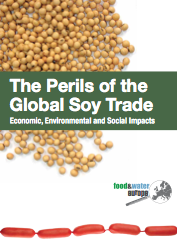The Perils of the Global Soy Trade: Economic, Environmental and Social Impacts
Europe: Globalization has fundamentally changed agriculture across Europe. The idyllic image of small farms with sustainable agriculture has been replaced with agricultural cogs producing food-ingredient inputs for international industrial agri-businesses. The pork chops and chickens on European tables begin their lives far away on soybean plantations in Latin America, where the feed for European livestock is harvested.
Globalization has fundamentally changed agriculture across Europe. The idyllic image of small farms with sustainable agriculture has been replaced with agricultural cogs producing food-ingredient inputs for international industrial agri-businesses. The pork chops and chickens on European tables begin their lives far away on soybean plantations in Latin America, where the feed for European livestock is harvested.
The international tentacles of the food chain tie deforestation in Brazil and Argentina to factory-farmed livestock in Europe. International trade agreements like the World Trade Organization facilitated the global corporate agri-business network that delivers soybeans and maize from Latin America to giant pig and chicken holdings in Europe and finally to a handful of supermarket chains.The beneficiaries of deregulated trade in agricultural goods have been the international grain traders, the investors in Latin American plantations, and the largest meatpacking and supermarket chains.
This paper connects the dots between the global agricultural commodity trade and the real-life impacts on consumers, rural communities in Europe and Latin America, and the environment. Findings include:
- European feed imports surged since the WTO went into effect. Since 1995, soy meal imports from outside the European Union to the 15 member states prior to 2004 (EU-15) grew 57.1 percent to 20.2 million metric tonnes in 2007. Total maize imports nearly doubled to 21.6 million metric tonnes.
- Soy exports from Latin America fueled deforestation. Four-fifths of EU soymeal imports came from Brazil and Argentina. The demand for more soybeans has been a key catalyst for clearing 44.5 million acres of forests in these two countries.
- Powerful soy interests drive small farmers off the land. Soybean plantations in Argentina and Brazil average about 1,000 hectares, but can be between 10,000 and 50,000 hectares. These large farms concentrate the land in the hands of a cadre of powerful investors and landowners, hurting indigenous farmers. There have even been reported cases of exploitation and enslavement of soy workers in Brazil.
- Industrial soy plantations feed European livestock genetically modified (GM) feed. In 2009, Brazil and Argentina were the second- and third-largest cultivators of GM crops (herbicide-tolerant or insect-resistant engineered seeds), growing 42.7 million hectares of GM soybeans, maize and cotton combined.
- Soybean imports supersized European pig and chicken farms. Low-priced soybean meal has helped reduce the number of European pig and chicken farmers and expand the scale of the remaining farms to gargantuan proportions. In 2007, 74 million pigs were fattened on the largest 1 percent of holdings — half of all pigs in the EU.
None of this is inevitable. Just as we created these changes, we can fix the problems with a few straightforward steps. Agriculture should be removed from the binding strictures of international trade agreements; nations should pursue farm policies that promote sustainable production, food sovereignty and food security for their populations; and food should be labeled to show the full life cycle of its production, including GM feed labeling for meat and dairy products. These are concrete steps we can take immediately to address the problems raised by the international soy and feed industrial complex and move toward improved food sovereignty in the EU and in countries that supply our food.



